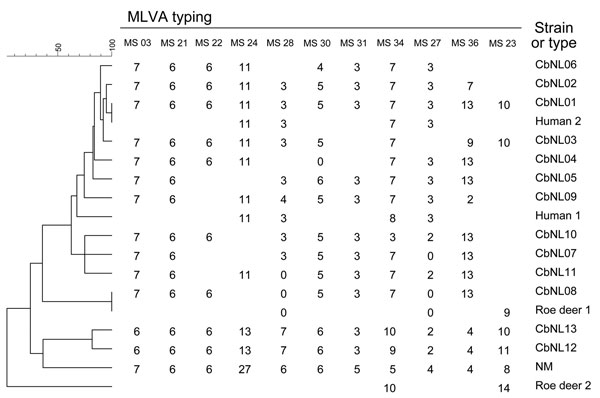Volume 17, Number 12—December 2011
Letter
Coxiella burnetii Infection in Roe Deer during Q Fever Epidemic, the Netherlands
Figure

Figure. Phylogenetic tree with genotypes of Coxiella burnetii from goat, human, and roe deer samples from the Netherlands. Genotypes were determined on the basis of 11 multilocus variable-number tandem-repeat analyses (MLVA). The number of repeats per locus is shown; open spots indicate missing values. Roe deer 1 was an adult female found dead on March 30, 2010, in Friesland Province. Roe deer 2 was a young female deer involved in a traffic accident on April 6, 2010, in Utrecht Province. The goat and human samples have been described (2). Scale bar indicates genetic relatedness. Human 1, QKP 1; Human 2, QKP 2; NM, Nine Mile reference strain; MS, MiniSatellite.
References
- Roest HIJ, Tilburg JJHC, van der Hoek W, Vellema P, van Zijderveld FG, Klaassen CHW, The Q fever epidemic in the Netherlands: history, onset, response and reflection. Epidemiol Infect. 2011;139:1–12. DOIPubMedGoogle Scholar
- Roest HIJ, Ruuls RC, Tilburg JJHC, Nabuurs-Franssen MH, Klaassen CHW, Vellema P, Molecular epidemiology of Coxiella burnetii from ruminants in Q fever outbreak, the Netherlands. Emerg Infect Dis. 2011;17:668–75.PubMedGoogle Scholar
- Astobiza I, Barral M, Ruiz-Fons F, Barandika JF, Gerrikagoitia X, Hurtado A, Molecular investigation of the occurrence of Coxiella burnetii in wildlife and ticks in an endemic area. Vet Microbiol. 2011;147:190–4. DOIPubMedGoogle Scholar
- van Rotterdam B, Langelaar M, van der Giessen J, Roest HJ, Gröne A. Q fever in wild animals in Europe, attention to hunters [in Dutch]. Tijdschr Diergeneeskd. 2010;135:420–2.PubMedGoogle Scholar
- Arricau-Bouvery N, Hauck Y, Bejaoui A, Frangoulidis D, Bodier CC, Souriau A, Molecular characterization of Coxiella burnetii isolates by infrequent restriction site–PCR and MLVA typing. BMC Microbiol. 2006;6:38. DOIPubMedGoogle Scholar
- Sukocheva OA, Marmion BP, Storm PA, Lockhart M, Turra M, Graves S. Long-term persistence after acute Q fever of non-infective Coxiella burnetii cell components, including antigens. QJM. 2010;103:847–63. DOIPubMedGoogle Scholar
- Aitken RJ. Delayed implantation in roe deer (Capreolus capreolus). J Reprod Fertil. 1974;39:225–33. DOIPubMedGoogle Scholar
- Woldehiwet Z. Q fever (coxiellosis): epidemiology and pathogenesis. Res Vet Sci. 2004;77:93–100. DOIPubMedGoogle Scholar
- Jones RM, Hertwig S, Pitman J, Vipond R, Aspán A, Bölske G, Interlaboratory comparison of real-time polymerase chain reaction methods to detect Coxiella burnetii, the causative agent of Q fever. J Vet Diagn Invest. 2011;23:108–11. DOIPubMedGoogle Scholar
Page created: November 30, 2011
Page updated: November 30, 2011
Page reviewed: November 30, 2011
The conclusions, findings, and opinions expressed by authors contributing to this journal do not necessarily reflect the official position of the U.S. Department of Health and Human Services, the Public Health Service, the Centers for Disease Control and Prevention, or the authors' affiliated institutions. Use of trade names is for identification only and does not imply endorsement by any of the groups named above.